Posted by Elena del Valle on August 29, 2008

25 Lessons book cover
Photos: Lorenzo Dominguez
Lorenzo Dominguez, a photographer, recently published 25 Lessons (Blurb Publishing, $39.95), a 130-page book about his life illustrated with 500 photos, almost all in color. In this first book he traced his journey from a stifled suburban husband and father, through the breakdown of his marriage and his refuge in a little church in Manhattan.
For three months he swapped caretaker duties for accommodations, living simply and by himself at the church. The stay provided him an opportunity to examine his life. He took advantage of his time by photographing New York City at night. This brought to his mind some of life’s lessons which he shared in the book.

Lorenzo Dominguez, author, 25 Lessons
“I wholeheartedly attribute much of the verve, the passion and the extraordinary appreciation I have for life to my Latin heritage. With 25 Lessons, I’ve attempted to convey much of this both through my words and photography,” said Dominguez. “I can sum up my philosophy about my art, my work and how I live my life in general with a traditional Spanish toast I like to propose whenever I am out, enjoying the company of my friends, ‘Al amor, dinero, salud, y el tiempo para gozarlos todos.'”
In the book, Dominguez shares his secret to the art of living and the simple rules of photography. He meant for the book to be inspirational and poetic; and to spark readers’ creativity, and reawaken their passion for life.
Dominguez grew up in California until he was 24, coming into contact with many Mexican Americans. In 1992, he moved to New York City to attend graduate school. There he encountered a different kind of Latin culture through new friends and neighbors of Puerto Rican, Dominican, Colombian and Cuban background.
He is a director of marketing and communications at a Fortune 500 company in New York City. He is a resident of Manhattan’s Upper West Side.
Dominguez is a graduate of the World Arts and Culture program at the University of California at Los Angeles, and a graduate of the School of International and Public Affairs program at Columbia University. His photography has been featured in fotoMagazin, a German photo magazine, and in 275 blogs, websites, and print publications.
“Moving Beyond Traditional Media Measurement: measuring conversations and social media” audio recording

Presenter Katie Delahaye Paine, founder, KDPaine & Partners
Find out about
- Issues affecting online public relationships today
- Testing relationships as part of a survey
- Measuring ethnic group relationships
- Measuring foreign language communications in a similar ways to English
- Biggest challenges measuring conversations and social media
- Measuring online relationships with little or no money
Click here for information on “Moving Beyond Traditional Media Measurement”
Comments:
Filed Under: Books
Posted by Elena del Valle on August 22, 2008

Treasure Hunt with the Munch Crunch Bunch cover
Photos: MunchCrunchBunch.com
Melinda Hemmelgarn R.D., M.S. and Jan Wolterman believe nutrition education has best results when it features creative and interactive material that involves the parents and child. To promote healthy eating among children they became coauthors of a 32-page self published booklet that does just that. Already they have sold 23,000 copies of the booklet, published in 2006, and available in English and Spanish.
According to a recent research study the Munch Crunch Bunch food characters in their book were likely to influence children, ages 5 to 8, to make healthy food choices. Children in the first and second grades completed a questionnaire tracking their intake of food. Following that task they participated in a nutrition education activity using the Treasure Hunt with the Munch Crunch Bunch story/activity book.
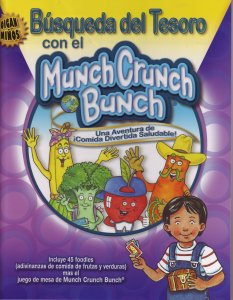
Búsqueda del Tesoro con el Munch Bunch Crunch book cover
Each child also took a book home to share with their family and to use on subsequent trips to the grocery store, utilizing the foodles (food riddle cards) to track down fresh fruit and veggies. Three weeks later, they responded to a second food questionnaire.
The results indicated intake of fresh fruits and vegetables had risen 24 percent and 14 percent respectively and intake of soda pop, fast food, and sweet snacks dropped significantly. Study results were independently reviewed by Ohio’s Evaluation and Assessment Center for Mathematics & Science Education.
Find out what multicultural kids across America think
Listen to Michele Valdovinos, SVP, Phoenix Multicultural in
“Marketing to Multicultural Kids” audio recording
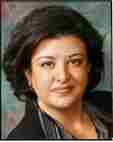
Michele Valdovinos gives a presentation and participates in an extended Q&A discussion about multicultural children based on a Phoenix Multicultural and Nickelodeon study of 1,300 multicultural children in 16 United States markets.
Find out about
• The Phoenix Multicultural Kids Study
• Relationship between children and their context
• Issues relating to family, technology and media, diversity, buying power, relationships in household, self perception, values, acculturation, cultural heritage, frequency of media activity, income and spending, brand preferences, the American Dream
• How many billions of dollars buying power multicultural kids children have
• Children’s spending attitudes, habits by ethnicity
• How much money a year Hispanic kids have available to spend
• Types of products Hispanic kids buy
Click here for information on “Marketing to Multicultural Kids” audio recording
“As a mother, I understand the power of getting kids involved in making good food, fun. The Munch Crunch Bunch can help change picky eaters into curious, hearty, healthy eaters,” said Hemmelgarn, who is a registered dietitian.

Jan Wolterman, coauthor, Treasure Hunt with the Munch Crunch Bunch
“Sad to say, things haven’t improved much over the years. In fact, they have gotten much worse. So I resurrected my Soup to Nuts food characters, renamed them the Munch Crunch Bunch and put them back to work educating, entertaining, and empowering children to junk the junk food and eat healthy. It’s a wonderful tool for parents and teachers to use with children ages 3 to 8,” said Wolterman.
The authors believe there is definitely a need for health and nutrition education material for Hispanic families with children. A Children’s Nutrition Research Center (CNRC) 2004 study at Baylor, Viva la Familia!, was designed to identify the reasons why so many Hispanic children develop serious weight problems.
Discover from a new mom market expert how to reach Latino moms by listening to
“Marketing to New Hispanic Moms – a case study” audio recording

Presenter Cynthia Nelson, COO, Todobebe
Find out about
• New Latina mom market
• Baby demographics including market size, profile
• New moms’ language preferences
• Latino baby market trends
• Factors influencing Hispanic baby market
• Location of new Hispanic moms’ market
• Issues affecting new Latino moms
• Todobebe strategies
Click for information on “Marketing to New Hispanic Moms – a case study”
“Obese children are more likely to suffer from additional health problems like insulin-resistant diabetes, high blood pressure, and orthopedic disorders,” said Nancy Butte, Ph.D., a Children’s Nutrition Research Center energy expert and associate professor of pediatrics at Baylor College of Medicine.
Hemmelgarn, founder of Food Sleuth, LLC, collaborates with educators, health professionals, organizations, foundations, and Universities on projects to improve public health, especially those related to youth and media literacy. Her goal is to reconnect kids to Mother Earth by promoting gardening and to empower children to make healthy food choices via fun and innovative educational programs.
Wolterman is a nutrition and health advocate for children. A freelance creative writer, she created a Soup to Nuts Puppet Theatre over 25 years ago along with resource material to educate children about healthy eating.
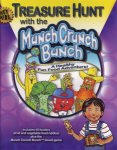
Click here to buy Treasure Hunt with the Munch Crunch Bunch
Comments:
Filed Under: Books
Posted by Elena del Valle on August 15, 2008
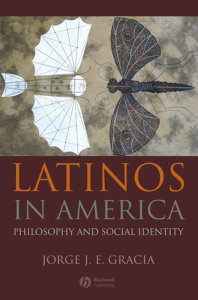
Latinos In America book cover
Photos: Wiley-Blackwell
Jorge J. E. Gracia, Ph.D. a professor of philosophy at the State University of New York (SUNY), explores the role of Latinos in United States society in a newly published book, Latinos In America (Blackwell Publishing, $29.95). He sets out to examine the attention and fear United States Latinos inspire within their own communities and within the country at large.
The 252-page soft cover book is divided into three main parts of three chapters each: Latino/a Identities, Latinos/as in Society and Latino/a Philosophy. He believes there is a great mis perception about Latino identity. Contrary to common belief, he espouses that there is no single common element that unites all Hispanics, and that ultimately the Latino community is highly diverse.
He explores the idea that many Hispanic are marginalized in the marketplace; he argues in favor of affirmative action as a remedy to the inequities that exist and the importance of teaching Latino children Spanish. Finally, he addresses Latino philosophy issues, including the negative image Latinos themselves have about the topic.
In the end he returns to the idea that it is not necessary to fear Hispanics. Latinos and non Latinos are not inherently separate like countries, he argues. Instead, they are like families. Related in some ways and not in others.

Jorge J. E. Gracia, Ph.D.
Gracia is Samuel P. Capen chair and SUNY distinguished professor, Department of Philosophy at the State University of New York. His academic credentials include: B.A. in Philosophy, with honors, Wheaton College, M.A. in Philosophy, University of Chicago, M.S.L. in Philosophy, magna cum laude, Pontifical Institute of Medieval Studies, and Ph.D. in Medieval Philosophy, University of Toronto.
He has authored 15 books. Recent publications are: Surviving Race, Ethnicity, and Nationality: A Challenge for the Twenty-First Century, The Classics of Western Philosophy, A Companion to Philosophy in the Middle Ages, and Hispanic/Latino Identity: A Philosophical Perspective.

Click here to buy Latinos in America
Comments:
Filed Under: Books
Posted by Elena del Valle on August 8, 2008

Good is Not Enough book cover
Photo: Portolio
Corporate executive Keith Wyche shares experience gleaned over 25 years working in some of America’s top-earning companies in Good is Not Enough: And Other Unwritten Rules for Minority Professionals (Portfolio, $24.95), his newly published title. In the 236-page hardcover book, Wyche sets out to advise minority readers who who want to climb the managerial ladder in corporate America.
His goal in writing the 12-chapter book was to address the power of perception, double standards, and the realities about corporate thinking and culture. He also shares suggestions for minorities to overcome the obstacles to success. The first time author emphasizes that today’s corporate America is much closer to political incorrectness than to the way things should be.

Keith Wyche, author, Good is Not Enough
“Yet in certain ways, today’s minority professionals, all of them, still have to reconcile their corporate advancement strategies with ‘the way it is’ in their corporate cultures, while still holding strong to their cultural integrity and core values,” said Wyche. “My goal is to provide insights from the inside of the executive suite and to help minority professionals see themselves through the same lens from which executive decision makers view them. From that lens, and based on my own experience, I can frankly tell them ‘good is still not enough’.”
According to Wyche, minority professionals who thrive in the corporate environment follow the unwritten rules instead of relying on their credentials or university degree. He also suggests aspiring ladder climbers should: learn how others see them because their perception can become reality; be informed; and be prepared with an exit strategy even when it doesn’t seem necessary.
Wyche emphasizes the importance of managing performance, exposure, and perception. In the book, he shares personal experiences to illustrate why he believes minorities must work harder than expected to advance their careers.
Wyche, a resident of Scarsdale, New York, is president of United States operations for Pitney Bowes Management Services, a division of Pitney Bowes Inc. Prior to that, he worked for Ameritech, AT&T, and IBM.

Click here to buy a copy of Good Is Not Enough
Comments:
Filed Under: Books
Posted by Elena del Valle on August 1, 2008

Quinceañera Connection cover
Photo: Priscilla Mills
California resident Gail Priscilla Mills has had a varied career including building a multi-million dollar business as well as being a life coach, business consultant and author. Seven years ago, while she provided life coaching and consulting to injured workers she heard the heartfelt stories of hardship of many of her clients, 70 percent of which were Latino.
Her client’s positive feedback about facing life challenges and their injuries, and often their desire to share what they had learned with their daughters, inspired her to write her first book, Quinceañera Connection: Your Dream Celebration On A Budget (American Treasures Library, $12.95). She also established a companion website to promote her book, offer positive content and offer products.

Click here to buy Quinceanera Connection
The 187-page soft cover book provides information for Latino families who want to celebrate their daughter’s coming of age on her 15 birthday. Quinceañera means fifteen year old girl in Spanish.
Quinceañera Connection is divided into four sections and 41 chapters including one section for the celebrant and another for the parents. The first section, Introduction, has two chapters. Section Two, Creating a Celebration has chapters 3 to 24. Section Three, Girl Talk for the Quinceañera, has chapters 25 to 33; and the final section is Parent Talk.
Mills is a graduate of the Harvard Business School-OPM program where she focused on entrepreneurial operations. She attended New York City College and University of California, Los Angeles. Mills was also the founder and chief executive officer of a multi-state inventory management company for over 15 years.

Click here to visit the Quinceañera website
Comments:
Filed Under: Books
Posted by Elena del Valle on July 18, 2008
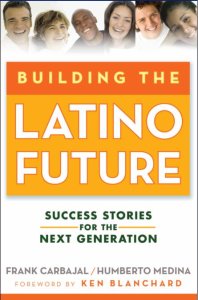
Building the Latino Future book cover
Photo: John Wiley & Sons, Inc.
Santa Clara resident Frank Carbajal, a life and business coach, and Humberto Medina, a speaker and consultant, teamed up to showcase the success stories of 49 Latinos in various professions and walks of life in the newly published book Building the Latino Future Success Stories for the Next Generation (Wiley, $24.95). The book is made up of brief summary biographies and a word of advice from each of the 49 individuals.
In addition to descriptions of the Latinos they chose to profile, the authors set out to provide readers with a framework they might rely on for their own future. The stories of the individuals they chose are designed to highlight their humble beginnings and rise to prominence in their field.
How to Use Your Energy to Attract Clients and Customers” audio recording

Presenter Heather Dominick, owner, EnergyRich Coaching, Inc.
A 106-minute audio recording including a presentation by Heather and the complete interview with Heather where she discusses:
- Heather’s step by step system for women entrepreneurs
- Her coaching philosophy that an individual needs to be business at a holistic level
- Core beliefs about creating magnificent marketing for your business
- How Heather transitioned from a high school drama teacher to a coach
- The three Os that characterized her life at the time
- Heather’s first steps to changing her life
Click here for information on How to Use Your Energy to Attract Clients and Customers
Not sure? Click here to listen to a short interview with Heather
Ready to buy? Select a format to add to your shopping cart:
Downloadable “ How to Use Your Energy to Attract Clients and Customers ” MP3 $119.95
Audio CD’s “How to Use Your Energy to Attract Clients and Customers ” $139.95
The 159-page hardcover book is divided into 49 chapters, one for each person profiled. The chapters are grouped in six sections: Focus, Unity, Tenacity, Unique Ability, Resiliency, and Education and a two-page Conclusion.
Included are 34 men and 15 women in academia, sports, business, entertainment, and politics from government as well as the private and private sectors such as: Aida Alvarez, former administrator, U.S. Small Business Administration; Raul Yzaguirre, former president, National Council of La Raza; Jeff Garcia, quarterback, National Football League; Elva Diaz, assistant professor, University of California at Davis; Douglas Patino, philanthropist; and Dick Gonzalez, former senior vice president, Human Resources, Safeway, Inc.
Carbajal is president of Es Tiempo, a coaching firm for small business owners and entrepreneurs. Medina is a speaker, director and consultant for The Ken Blanchard Companies.

Click here to buy Building the Latino Future
Comments:
Filed Under: Books
Posted by Elena del Valle on July 11, 2008
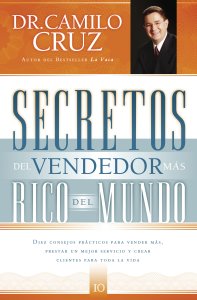
Secretos del Vendedor Más Rico del Mundo book cover
(Successful Secrets From the Wealthiest Salesman in the World)
Photos: Grupo Nelson
Entrepreneur and speaker Camilo Cruz, Ph.D. believes everyone is a salesman and he sets out to explain his secrets of selling in his new Spanish language book Secretos del Vendedor Más Rico del Mundo (Successful Secrets From the Wealthiest Salesman in the World). Although the book was written with salesmen in mind, promotional materials promise it contains universal concepts applicable for achieving success in any area of life.
On the cover of his ambitiously titled soft cover 204-page book, Cruz promises 10 practical tips to sell better, offer better service and create clients for life. Published by Grupo Nelson, a division of Thomas Nelson Publishers, the book sells for $14.99.
“We are all salespeople! Whether we are aware of it or not, we are constantly selling something,” said Cruz who has a Ph.D. in chemistry from Seton Hall University. “Entrepreneurs sharing business opportunities with others, parents persuading their children to adopt the proper values and principles to be successful in life, professionals offering their skills and talents-they are all selling.”

Author Camilo Cruz, Ph.D.
“Segmentation by Level of Acculturation” audio recording

Presenter Miguel Gomez Winebrenner
Discusses
- Assimilation versus acculturation
- Factors that affect Latino acculturation
- How to know if someone is acculturated
- Number of years necessary for acculturation
- Effects of immigration debate on acculturation
- Three main ways of segmenting Latinos
Click here for details about “Segmentation by Level of Acculturation”
He relies on the idea that selling is more than a presentation of products; instead he believes it has to do with the way people communicate their ideas, offer their services or introduce their talents and professional skills to prospects.Cruz has had 26 books published with combined sales of more than a million copies. His book, La Vaca (Once Upon a Cow), also written in Spanish, was translated into more than twelve languages.
Cruz has launched three companies. He co-founded Yupi Internet, a Spanish-language portal acquired by Microsoft. He is the founder of Taller del Éxito Group, a training and motivational company based in Latin America, and ElExito.com, a self-improvement portal for Spanish speaking Latinos.

Click here to buy Secretos del vendedor mas rico del mundo
Comments:
Filed Under: Books
Posted by Elena del Valle on June 27, 2008

Happy for No Reason book cover
Photo: Marci Shimoff
Since she was a young girl Marci Shimoff has been trying to understand happiness. As an adult with an established national reputation as a speaker and author she decided to pursue this quest by asking the 100 happiest people she could find about their lives. From their responses and her research on the subject she and her co-author Carol Kline, outlined a seven-step process she shares with readers in Happy for No Reason 7 Steps to Being Happy from the Inside Out (Free Press, $24.95).
The 320-page hardcover self-help book was published in early 2008 and immediately began selling at a brisk pace. In the book, divided into three parts, she discusses happiness and how readers can develop seven happiness habits that may lead eventually to enhanced feelings of well being. Each chapter includes one case study from the Happy 100 individuals, some of them celebrities, Shimoff interviewed.
Her suggestions include looking after body, soul and relationships and working toward higher goals beyond an individual’s well being. She emphasizes that money alone doesn’t make people happy.
In Part I, Happiness That’s Here to Stay, there is an introduction and two chapters, Happy for No Reason… Really? and Practicing Happiness. Part II, Building Your Home for Happiness, is chapters 3 to 9 in which she describes developing happiness habits in: The Foundation, Take Ownership of Your Happiness; The Pillar of the Mind, Don’t Believe Everything You Think; The Pillar of the Heart, Let Love Lead; The Pillar of the Body, Make Your Cells Happy; The Pillar of the Soul, Plug Yourself In to Spirit; The Roof, Live a Life Inspired by Purpose; and The Garden, Cultivate Nourishing Relationships.
Part III, Happy for No Reason Ever After, includes the final chapter, The Happy for No Reason Plan for Life, as well as Recommended Resources, Acknowledgments, Giving Back and bios of the authors and the Happy 100.
Shimoff, one of the authors of the Chicken Soup for the Soul, authored six titles in the series, including Chicken Soup for the Woman’s Soul and Chicken Soup for the Mother’s Soul. According to promotional materials, those books have sold more than 13 million copies worldwide in 33 languages and have been on The New York Times bestseller list for 108 weeks.

Click here to buy Happy for No Reason
Comments:
Filed Under: Books
Posted by Elena del Valle on June 13, 2008
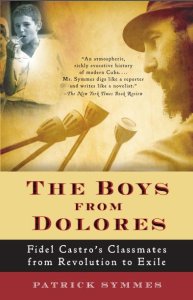
The Boys from Dolores book cover
Photo: Stephen Lewis
In The Boys from Dolores Fidel Castro’s Schoolmates from Revolution to Exile, a recently published book (Vintage, $15.95), Patrick Symmes tells the story of some of Cuba’s privileged boys from days gone by. Fidel Castro and his brother Raúl are among the many boys that attended the Colegio de Dolores, a private school on the island, in the 1940s.
In the 352-page book, the New York author describes the story of a group of boys he believes were an essential part of Cuba’s political and social history. The boys, chosen from among the most affluent and ambitious families in eastern Cuba, were groomed at the school Colegio de Dolores for achievement and leadership.

Author Patrick Symmes
According to promotional materials, Symmes tracked down dozens of schoolmates and shares some of their stories in the book. He includes their time at the Colegio and the effects of the revolution on their lives. The boys, he tells the reader, were trained by Jesuits for dialectical dexterity and the pursuit of absolutes.
He goes on to describe Fidel Castro in his formative youth, as an adolescent in the Colegio and in the streets of Santiago, the province where the school was located. Symmes traces the years in which the revolution was conceived and its evolution. He also describes the changes it produced in Santiago and in the lives of the boys. With Symmes’ help the reader can follow the boy’s life through the 1960s, as many left Cuba and a few stayed behind.
Symmes sets out to provide readers with a tour of the world that gave birth to Fidel Castro and the island his Cuban Revolution left behind. It is described as an “eye-opening portrait of Cuba in the twentieth century.” Symmes, a resident of New Yok, is the author of Chasing Che. He writes for Harper’s, New York, Outside, and Conde Nast Traveler magazines.

Click here to buy The Boys from Dolores
Comments:
Filed Under: Books
Posted by Elena del Valle on May 30, 2008

Raising a Bilingual Child book cover
Photos: Living Language
Linguistics expert Barbara Zurer Pearson, Ph.D. believes it’s healthy to raise children speaking two or more languages. She explains why in her recently published book, Raising a Bilingual Child: A Step-by-Step Guide for Parents (Living Language, $14.95). Pearson, a research associate at the University of Massachusetts, first became bilingual as a university exchange student in Paris, France. She has dedicated 20 years to studying bilingualism and linguistics and believes parents don’t have to be bilingual themselves to raise bilingual children.
The 346-page soft cover book is divided into eight chapters: The Benefits of Childhood Bilingualism; Learning a First Language; Learning Two (or More) Languages; Establishing a Bilingual Environment; How-To Testimonials; Are There Any Children Who Cannot Learn Two Languages?; Research Comparing Monolinguals and Bilinguals; and About Bilingual Identity. Each chapter begins with an outline of the content and what the reader will find. There are 11 tables and 11 figures spread across the book.

Author Barbara Zurer Pearson, Ph.D.
In her book, Pearson strives to shows parents how to raise a bilingual child and realize the intellectual and cultural benefits knowing more than one language may bring; while exploring the fascinating process by which children acquire language. She dedicates part of her book to dispelling myths about childhood bilingualism and explains how being bilingual can enhance a child’s overall intellectual and emotional development.
Improve your outreach programs by understanding
how Latinos see themselves – listen to
“Latino Identity and Situational Latinidad ” audio recording


Presenters Diana Rios and Ph.D., Federico Subervi, Ph.D.
Find out
• Who is Latino
• Assimilation, acculturation and pluralism
• Hispanic culture dynamics affecting Latino
• Role of Latino identity
• Three factors that contribute to Latino identity
Click here for information on Latino Identity and Situational Latinidad
Pearson highlights some of the reasons why monolingual and bilingual parents choose to raise their children bilingually: to take advantage of a broader job market that may offer greater opportunities and a competitive edge to bilingual or multilingual applicants; to improve relationships with extended family members that link them to their parent’s culture and their heritage; and as part of an international adoption some new parents believe learning the language of their home country may help adopted children remain in touch with their heritage.
She also outlines ways parents can provide the right home environment to encourage and support bilingualism. She suggests they start young whenever possible; encourage the child to learn a second language by making it a fun experience; repeatedly praise the benefits of bilingualism; include the second language in the child’s routine; and make sure there are group activities that involve the second language.
Pearson is an adjunct professor in the Department of Communication Disorders at the University of Massachusetts-Amherst. She received her graduate degree in Applied Linguistics and conducted her early research on bilingualism at the University of Miami. Those studies were published in the book Language and Literacy in Bilingual Children.
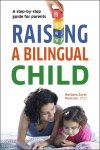
Click here to buy Raising a Bilingual Child 
Comments:
Filed Under: Books












































